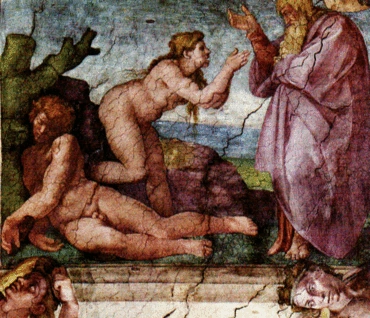Explanation of Genesis 2:22
Po Brian David

The Lord is life itself. We are recipients of life. We give life unique forms because of our unique shapes as receptacles, and through free will we can choose how fully we will receive life. But we don't have life of our own. It follows from this that the more we turn toward the Lord and receive life, the more alive we will be; and the more we turn away the more dead we will be. It also follows that believing life is our own – with all the loves, the thoughts and the power that entails – is actually the antithesis of life.
This is the state of those in the deepest hells, who reject everything of the Lord, even His existence, and claim all life as their own. They are, in fact, only alive because the Lord forces life on them in the amount necessary to sustain existence.
This is, in a sense, what is represented by the rib – which is human, and is alive, but only in the most limited way. When the people of the Most Ancient Church (Adam) wanted to lead themselves and sense life as their own, the Lord had to use that most dead aspect of them to grant their wish. He had to use that bone, which represents our most hellish potential, what we would be if we were to reject the Lord completely.
But then the Lord did something miraculous. He turned that bone into living flesh, into a new person: the woman Eve. This represents that the Lord built that most dead, most hellish aspect of us up into something which felt life as its own, but could acknowledge that life actually came from the Lord, and could thus again be a recipient of life. It wasn't quite as pure as before; people could no longer commune directly with the Lord. But they had what they wanted instead: a sense of self.
The Writings call this – both the rib and the woman – by the Latin word proprium, essentially meaning "as of self." The rib represents the proprium on its own, which is hellish. The woman represents the proprium given life by the Lord.
(Reference: Arcana Coelestia 151, 152, 153, 154, 155)
Seven
Seven, as in Revelation 15:1, signifies everything in an universal sense. The number 'seven' was considered holy, as is well known, because of the six days of creation, and the seventh, which is the celestial self, where peace, rest, and the Sabbath is. The number seven occurs so frequently in the rites of the Jewish church and is held holy everywhere.
So times were divided into seven, longer and shorter intervals, and were called weeks, like the great intervals of times till the coming of the Messiah, in Daniel 9:24-25. The time of seven years is called 'a week' by Laban and Jacob, as in Genesis 29:27-28. So wherever the number seven occurs, it is considered holy and sacred, as in Psalm 119:164, and in Isaiah 30:26.
As the periods of a person's regeneration are distinguished into six, prior to the seventh, or the celestial self, so the times of vastation are also distinguished, until nothing celestial is left. This was represented by the many captivities of the Jews, and by the last Babylonian captivity, which lasted seven decades, or seventy years. This was also represented by Nebuchadnezzar, in Daniel 4:16, 22, 29. It also refers to the vastation of the end times, in Revelation 15:1, 7-8. They should 'tread the holy city under foot, forty and two months, or six times seven,' as in Revelation 11:2 and Revelation 5:1. So the severity and increments of punishment were expressed by the number seven, as in Leviticus 26:18, 21, 24, 28 and Psalm 79:12.
(Reference: Apocalypse Explained 5, 7-8, 15; Arcana Coelestia 395; Daniel 9, 9:24, 9:25; Psalms 119)






